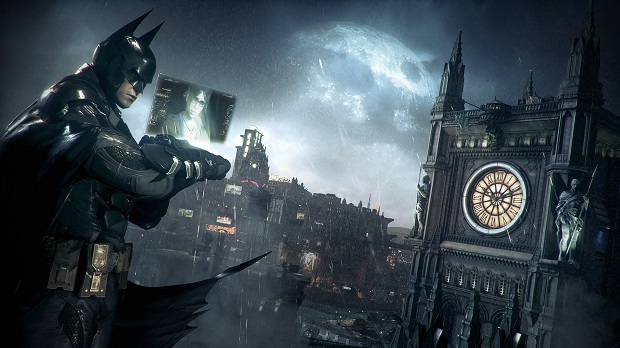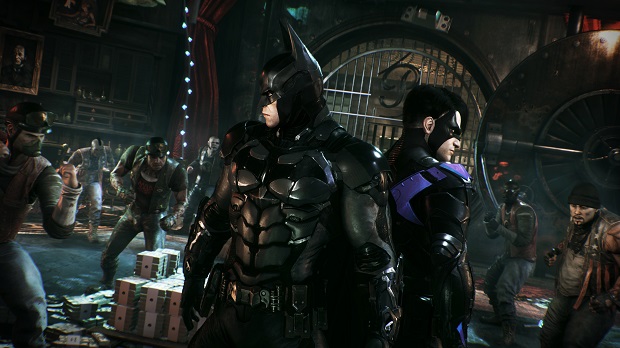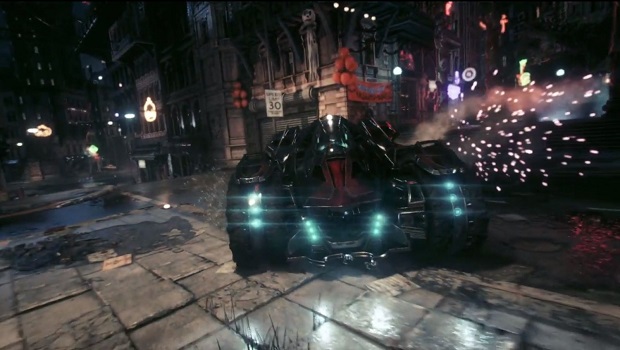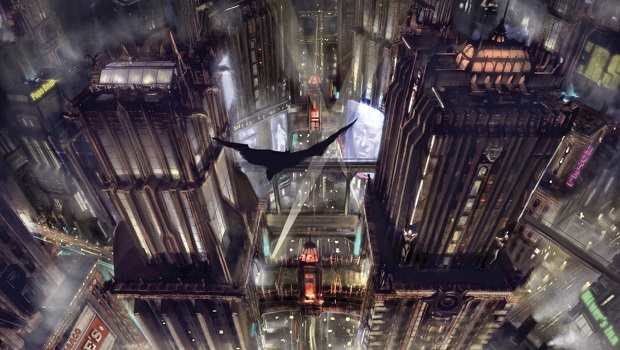Batman: Arkham Knight is one of the more maddening efforts I have played in recent memory. The core gameplay is better than it ever was, with both predator and combat sequences built dynamically into the world, naturally flowing together with the game’s open nature. If the game focused on these elements, the actual “Batmaning,” if you will, we might be talking game of the year candidate. Yet, bizarrely, the game is centered around not Batman, but his ride, and puts its worst elements at the forefront far too often.
Arkham Knight opens with the villain Scarecrow threatening Gotham City with certain destruction. The city is evacuated, leaving Batman to confront Scarecrow and his allies without any civilians present anywhere. It’s a convenient premise, and one that allows a similar “beat the crap out of anyone you encounter because they are evil” environment that we had in both Arkham Asylum and Arkham City. It was also the first of numerous qualms I had with the game’s storyline. Batman consistently takes absurd risks to rescue the people of Gotham, people who aren’t there right now. The city’s evacuation removes the sense of urgency from the situation, and I am left to wonder why I absolutely have to dive into yet another impossible situation RIGHT NOW. Who am I saving?
The storyline, a strength of the previous games, is muddled and lacks punch. Scarecrow, a villain who strikes at the fear within us all, isn’t scary. He serves more as an annoying, mocking narrator, who repeatedly fails to meet that standard that every rudimentary editor knows: show me, don’t tell me. The plot’s treatment of the awesome female characters of the Batman universe lies somewhere between cliched, woman in the refrigerator crap and overt misogyny. And while I found the device the game used to convey Batman’s battle for his sanity to be compelling at first, it gets overused, like a great pop song played too many times on the radio, and then played some more.
The free flow combat of the previous games returns here, and it is fun as ever. There’s still nothing quite like dropping into a group of 20 thugs and beating the crap out of them. Arkham Knight adds a few new wrinkles. Some of the fights are in tandem with other superheroes, allowing for tandem takedowns and character switching. Some of the Riddler fights use this switching to add a puzzle aspect to the combat that is really interesting. The game also adds some cool environmental takedowns, and, when in presence of the Batmobile, it too can be used to add some spice to the old art of fist-to-face.
The game’s predator sequences are built right into the world. That is, the majority of them don’t have Batman trapped in an enclosed space, but allow him to escape out into Gotham and return from a new angle. This, to me, makes a lot more sense, and allows for more creativity as you take down the group of armed foes. Some additional gadgets, including one which disables your opponent’s’ weapons without their notice, allow for some new opportunities. There are also now fear takedowns, which allow Batman to ambush a group of armed foes, taking them each out in one button press, using the fear caused by his sudden appearance. It’s a nice change.
Batman, now out in his largest world ever, needs to travel in style. Arkham Knight features the Batmobile, a decision, which both for good and ill (mostly, in my opinion, ill) affects every other aspect of the game. The Batmobile is a cross between a race car and a tank, tearing through the city streets, rolling over or going through any obstacle in its way. When the game uses the Batmobile well, in chase sequences and in puzzle solving, it’s quite entertaining and fun to use. However, too often the game uses the Batmobile in tank battle sequences, which come to dominate much of the campaign and a large number of the side quests. The tank battles aren’t fun, and the game’s idea of “variety” in the numerous instances you are forced to fight in them is to include increasing numbers of foes. The Batmobile is also responsible for some of the worst boss battles in recent memory, including one particular underground sequence where the tank-like controls of the vehicle are suddenly expected to allow deft maneuvering in a closed space. For every step forward the Batmobile adds to the franchise, it takes two annoying, slap-in-the-face level steps back.
Batman isn’t confined to the Batmobile, and can fly across the city using his Batclaw and cape. As he wanders, he can hunt down side quests, which vary from exciting (stopping Two Face from robbing a bank, or destroying the Penguin’s weapon caches with Nightwing) to intriguing (the Riddler always makes things interesting, and knocks you off your ego perch) to monotonous (fight tanks in a close radius… again, or track down the 250 Riddler trophies). Some of the side missions (especially the Riddler ones) were more interesting than the missions in the main campaign, and many of them include appearances from villains across the Batman universe. There are a lot of them, however, and this is where one of the game’s most bizarre design decisions lies. The true ending of the game is locking behind completely 100% of everything. This includes tracking down all the RIddler trophies. I’m not really sure why anyone thought this was a good idea, so I did the side missions I enjoyed, completed the campaign, and watched the ending on YouTube. It was very nice.
I love the parts of Arkham Knight that allow me to be Batman, to be invincible in hand-to-hand combat, and fearsome to my confused and terrified enemies. But too often, Arkham Knight emphasizes its other aspects, and between the oddly-prevalent tank combat, the weak storyline, and some other odd decisions (like hiding the game’s true ending behind 100% completion), I’m left wondering what might have been. As the game opens, it tells you this is how the Batman dies. I seriously hope that is not the case.




